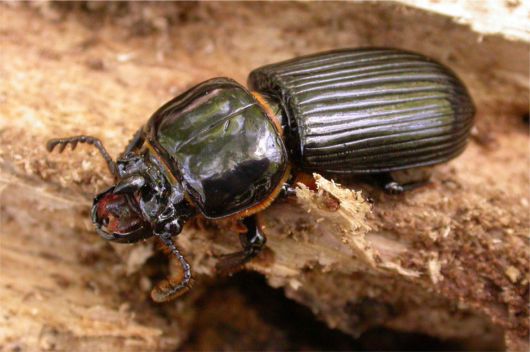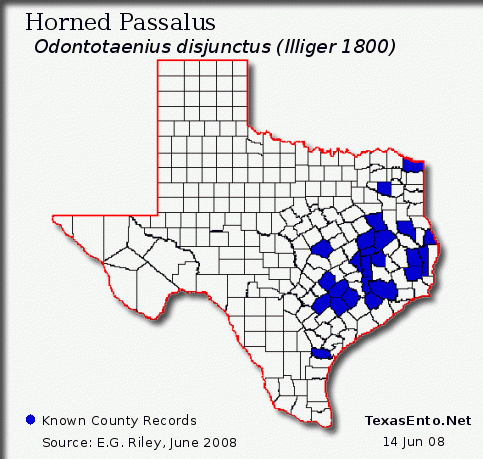
|
Return to Texas Entomology - Compiled by Mike Quinn

|
(note sublamellate antennal club, a family characteristic)

|
Primary Source: Ed G. Riley, June 2008
Range:
Nebraska, southern Manitoba and east Texas throughout the eastern U.S. and Canadian deciduous forests, south to the middle of Florida and north to Massachusetts and southern Ontario. (Arnett et al. 2002)
Adult Activity: Year round
Biology:
Passalid adults (of both sexes) and larvae live together in subsocial groups in large rotting logs. Adults care for larvae and prepare food by chewing it and presumably mixing it with saliva. Adults and larvae need to feed on adult feces that are predigested by microflora (essentially and external rumen). (Arnett et al. 2002)
Associates:
Like other beetles, passalids are infested with ectoparasitic and phoretic mites but in greater variety that any other family of insect hosts. Trichomycetes fungi are found in the gut of both larvae and adults and may be involved in cellulose digestion (Lichtwardt 1986)
Sounds:
Both adults and larvae produce a repertoire of sound that apparently serve a number of purposes in their complex life histories. Prevalent signals express disturbance, aggression. and courtship (Schuster & Schuster 1971, Schuster 1983). Some 14 different acoustic signals have been recognized, associated with eleven behavioral actions, the most known for any arthropod species (Schuster 1983).
Similar Species:
There are over 500 described species of passalids, nearly all of which are tropical (Arnett et al. 2002).
Riley & Wolfe (2003) report that only one species of passalid, Odontotaenius disjunctus (Illiger), is confirmed for Texas. Hincks & Dibb (1935) report two other passalid species from Texas with no further locality data. These dubious species attributed to Texas are widely cited in the literature even though one gets no closer than Panama. Riley & Wolfe (2003) recommend the removal of these species from future listings of Texas Coleoptera.
Some 90 species of passalids occur in Mexico. (Arnett et al. 2002).
Five passalid species are known to occur in Mexico within 100 miles of the Texas border (Schuster, 1983).Schuster (1983) reported that Ptichopus angulatus (Percheron) was collected at Matamoras, in Tamaulipas, Mexico. This species is known to live in association with the leaf-cutting ant Atta mexicana F. Smith, and A. cephalotes (Linnaeus), but has not been recorded in association with the Texas leaf-cutting ant, A. texana (Buckley). Atta texana occurs in the lower Rio Grande valley. Large colonies have been observed on the banks of the Rio Grande in Starr County. (Riley & Wolfe 2003)
Odontotaenius floridanus Schuster, 1994 - endemic to certain sandhill areas of central Florida
Websites:
Overview - University of Nebraska State Museum, Division of Entomology
Literature on Passalid Beetles after 1960 - Rev. 12-1999
Photos:
Eggs & First Instar Larvae, Adults & Mature Larvae, Teneral Adult, Horn Close-up - BugGuide.Net
Mature Passalidae Larvae from Ecuador - Note highly reduced hind legs are modified for stridulation
Etymology: Odontotaenius disjunctus (Illiger 1800)
odon, t, -to (G). A tooth
taeni, =a, -o (G). A band, ribbon
dis (G). Separate, apart; double, two
junc, =us (L). A rush, reed
Alternate Common Names: Bess Beetle, Bess Bug, Betsy Beetle or Bug, Patent-leather Beetle (Pin-pin, Spanish)
"Bess" probably comes from French baiser, "to kiss", and probably refers the sound of the stridulation.
Biography: Johann Karl Wilhelm Illiger (1775 - 1813) - Wikipedia
Bibliography:
Arnett, R.H., Jr., M.C. Thomas, P.E. Skelley & J.H. Frank. (editors). 2002. American Beetles, Volume II: Polyphaga: Scarabaeoidea through Curculionoidea. CRC Press. 861 pp.
Borror, D.J. 1960. Dictionary of Word Roots and Combining Forms. National Press Books, Palo Alto. v + 134 pp.
Gray, I.E. 1946. Observations on the Life History of the Horned Passalus. American Midland Naturalist, 35(3): 728-746.
Hinds, W.E. 1901. Strength of Passalus cornutus Fabr. Entomological News 12: 257-262.
Hincks, W.D. & J.R. Dibb. 1935. Pars 142. Passalidae. In: S. Schenkling (ed.), Coleopterorum Catalogus. W. Junk, Berlin. 118 pp.
Lichtwardt, R.W. 1986. The Trichomycetes: fungal associates of arthropods. Springer-Verlag, New York. 343 pp.
MacGown, J.A. & M.J. MacGown. 1996. Observation of a nuptial flight of the horned Passalus beetle, Odontotaenius disjunctus (Illiger) (Coleoptera: Passalidae). The Coleopterists Bulletin 50: 201-203.
Reyes-Castillo, P. 1970. Coleoptera, Passalidae: Morfología y división en grandes grupos; géneros americanos. Folia Entomol. Mexicana 20-22: 1-240.
Reyes-Castillo, P. and G. Halffter. 1984. La estructura social de los Passalidae (Coleoptera: Lamellicornia). Folia Entomologica Mexicana 61: 49-72.
Riley, E.G. & C.S. Wolfe. 2003. An annotated checklist of the Scarabaeoidea of Texas. Southwestern Entomologist, Supplement, no. 26. 37 pp.
Schuster, J.C. 1975a. A comparative study of copulation in Passalidae (Coleoptera): New positions for beetles. Coleopterists Bulletin 29: 75-81.
Schuster, J.C. 1975b. Comparative behavior, acoustical signals and ecology of New World Passalidae (Coleoptera). Ph.D. Thesis. University of Florida. 127 pp.
Schuster, J.C. 1983a. The Passalidae of the United States. Coleopterists Bulletin 37(4): 302-305.
Schuster, J.C. 1983b. Acoustical signals of passalid beetles: complex repertoires. Florida Entomologist 66: 486-496.
Schuster, J.C. 1984. Passalid beetle (Coleoptera: Passalidae) inhabitants of leaf-cutter ant (Hymenoptera: Formicidae) detritus. Florida Entomologist, 67: 175-176.
Schuster, J.C. 1992. Passalidae: state of larval taxonomy with description of New World species. Florida Entomologist 75: 358-369.
Schuster, J.C., & L.B. Schuster. 1997. The evolution of social behavior in Passalidae, Pp. 260-269 In: Choe, J. & B. Crespi. (eds.), The Evolution of Social Behavior in Insects and Arachnids. Cambridge University Press, Cambridge.
Taber, S.W. & S.B. Fleenor. 2003. Insects of the Texas Lost Pines. Texas A&M University, College Station. 283 pp.
Taber, S.W. & S.B. Fleenor. 2005. Invertebrates of Central Texas Wetlands. Texas Tech University Press, Lubbock. 309 pp.
14 Jun 2008 © Mike Quinn / entomike@gmail.com / Texas Entomology / Texas Beetle Information